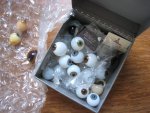Interesting discussion. Advance warning: I hate the term eye box and do not use it, so bear with me. To me, this is an eye box:
The size of the exit pupil has an immediate and significant effect on flexibility of eye relief. Small exit pupil means that your eye has to be positioned very precisely behind the scope. However, optical design matters too, especially for how much leeway you have in terms of fore and aft positioning of your eye (less so for lateral positioning).
March scopes are very well built and engineered, but they do have pretty tight restrictions in terms of eye positioning. A lot of it is a consequence of very broad focus range and shallow DOF of the optical systems they use.
A lot of that can be mitigated by proper scope and stock set up, but, obviously not all of it and for disciplines that involve unorthodox shooting positions, March is usually not the optimal choice. Scope selection is a compromise: choose what is important to you. When March first came out with the 2.5-25x42, 3-24x42 and other high erector ratio scopes, you could not get such a broad magnification range anywhere else. Whether you need it is a separate question, but if you wanted ultimate flexibility, March was the only game in town. Now, there is a lot more competition, so it is a different story.
Personally, I liked the original 3-24x42 quite a bit and used it for a few years. However, I mostly shot it in the 8x to 14x range and only dialed it up to top magnification when I had the leasure to do so.
Kahles, mentioned above, probably has the most flexible eye relief of all the precision scope currently available. That and wide FOV is sort of a point of pride for Kahles, so they design their product accordingle. S&B, Minox, Tangent Theta, etc are somewhere in between in and offer a very good compromise of a little bit of everything. Personally, I am a big Tangent Theta fan, partly because of the turrets, partly because of the optics. Eye relief flexibilit on it is very respectable, but not as good as Kahles. Steiner Military scopes also have very flexible eye relief in my experience.
Vortex has really paid a lot of attention to the eyepiece design in recent years (ever since they had to re-design the eyepiece on the Gen 1 Razor) and the eye relief flexibility on the Razor Gen 2 and AMG is excellent. I am currently testing the AMG and I really like it. I prefer lighter scopes, so for my purposes it is a better fit than the Gen 2 (and Vortex is going to get it back from me over my dead body; or if my wife finds out that I am planning to buy it, which may the same thing).
Last point to address: matching of exit pupil to eye pupil. I have heard people say that once the exit pupil of the scope exceed the size of your eye pupil, it is just wasted light. That is simply not true. It gives some space for your eye to move around and increases image fidelity (your brain likes to process multiple images from slightly different eye positions). It also helps with eye fatigue.
Generally, the more your eye pupil dilates the worse is the image quality that they eye delivers to your brain, so in low light, every little bit helps.
ILya




